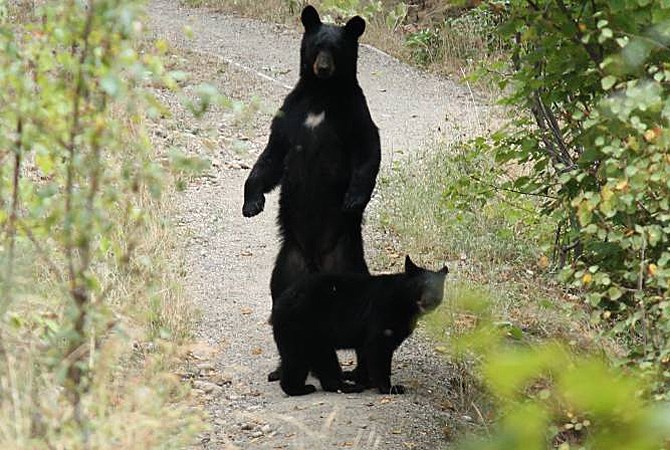
This black bear sow and her cub were spotted on the Mission Creek Greenway.
Image Credit: Brenda Martinson/Global Okanagan (with permission)
September 21, 2015 - 6:30 PM
WEST KELOWNA – A busy weekend for bear sightings in West Kelowna could signal the start of a fall rife with bear-human conflicts.
Frank Ritcey, the creator of the interactive Wildlife Alert Reporting Program on WildsafeBC.com, says four sightings of black bears were reported in the Shannon Lake neighbourhood in West Kelowna since Friday.
“This past month has been an exceptional month already,” he says. “It’s a concern when they begin accessing non-natural foods because that brings them closer to humans and it's a safety concern.”
He says it’s not unusual for there to be more bears in the city during the fall but the unusually hot, dry summer has caused much of their natural food sources to die off early and instances are becoming a real problem.
“September is always our highest month for bear calls because the bears are … eating upwards of 20,000 calories a day … to increase their body mass by 30 per cent so they’ve got enough fat stored to make it through hibernation,” he says. “The berry crops have finished early so the bears have been more stressed for finding food.”
B.C. Conservation officer Jim Beck says there were 24 bear complaints in one day in the South Okanagan recently.
“It’s crazy out there," he says. "I know the boys in the north are run off their feet too.”
Most of the bear sightings around the Okanagan have something in common.
“These are all garbage bears,” Ritcey says. “It’s unfortunate because that is the easiest situation to avoid. It’s a real problem.”
Bears are attracted to garbage because it is calorie rich and available. That, he says, could mean more bears in the area in the coming years as bears will only have as many cubs as their body can support.
“The bear’s body knows whether it can support the raising of young so if they’ve got lots of garbage and high calories then you’re going to see a lot more twins and triplets.”
He says 20 years ago it was very unusual to see a sow with more than one cub, but that it is becoming more and more frequently.
“It’s pretty commonplace now,” he says. “That’s all a direct result of the bear access to more calories. Two years down the road there’s going to be that much more conflict because there are that many more bears around.”
For more information on how to avoid attracting bears, visit the Wildsafe B.C. website.
To contact the reporter for this story, email Adam Proskiw at aproskiw@infonews.ca or call 250-718-0428. To contact the editor, email mjones@infonews.ca or call 250-718-2724.
News from © iNFOnews, 2015